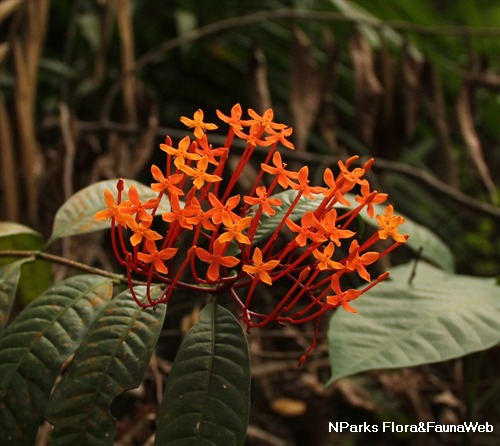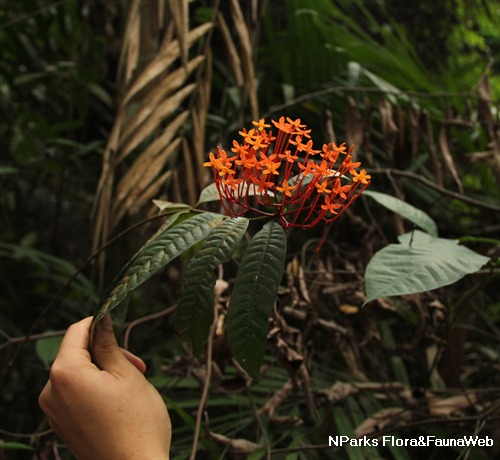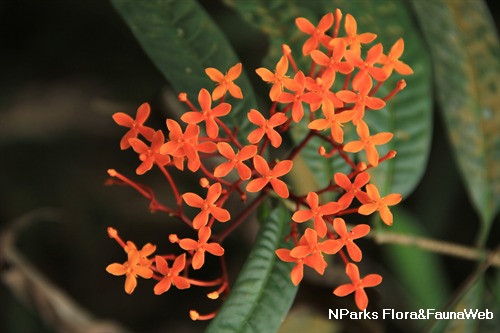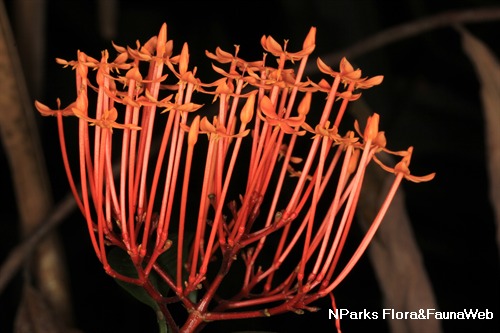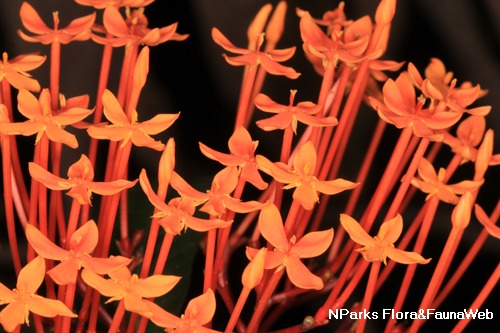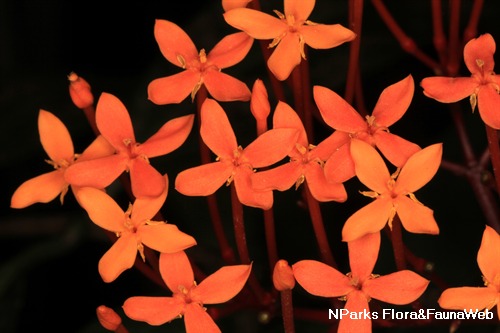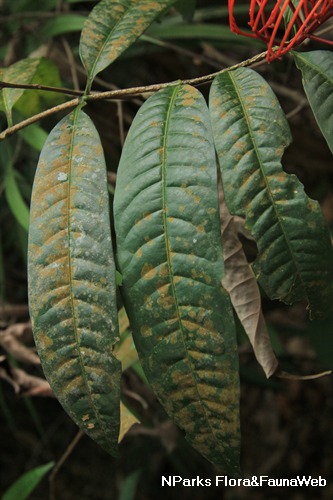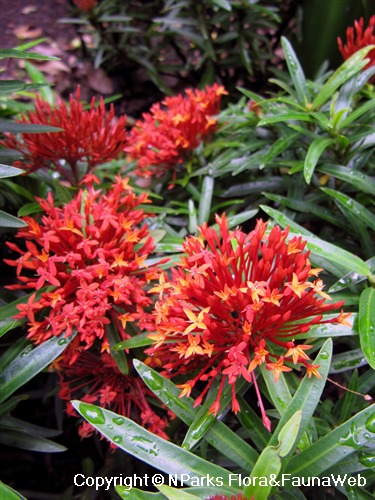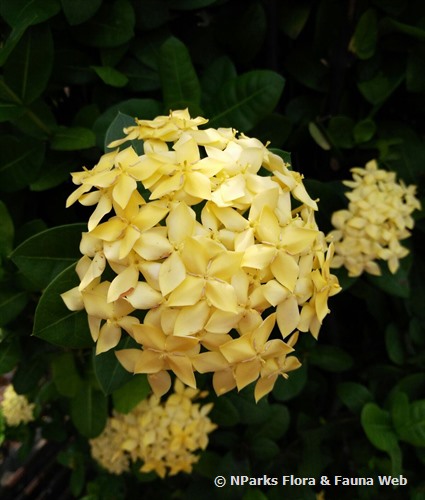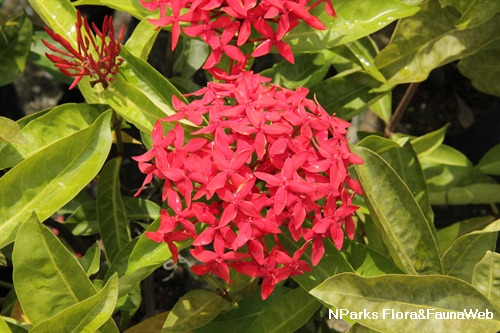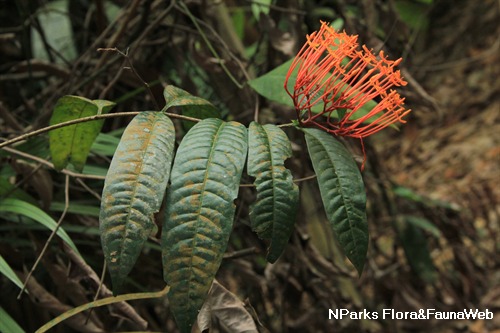
Back
Ixora lobbii Loudon ex King & Gamble var. lobbii
| Family Name: | Rubiaceae |
| Common Name: | Glossy Ixora, Bunga Selang, Kramat Hujan, Penabas |
Name
Classifications and Characteristics
| Plant Division | Angiosperms (Flowering Seed Plants) (Dicotyledon) |
|---|---|
| Plant Growth Form | Shrub, Tree (Shrubby (1m-5m), Small (6m-15m)) |
| Lifespan (in Singapore) | Perennial |
| Mode of Nutrition | Autotrophic |
| Plant Shape | Irregular |
| Maximum Height | 2 m to 10 m |
Biogeography
| Native Distribution | Thailand, Peninsular Malaysia, and Singapore |
|---|---|
| Native Habitat | Terrestrial (Primary Rainforest, Secondary Rainforest) |
| Preferred Climate Zone | Tropical, Sub-Tropical / Monsoonal |
| Local Conservation Status | Native to Singapore (Endangered (EN)) |
Description and Ethnobotany
| Growth Form | It is a shrub or small tree up to 10 m tall. |
|---|---|
| Foliage | Its opposite, stalked leaves have leathery blades that are usually elliptic to lance-shaped with a pointed tip, 15–20 by 3.8–5 cm, and have 15–25 pairs of veins. |
| Flowers | Its flowers are bright orange-red, 3.8 by 4.4 cm, with red flower stalks, and arranged in stalkless clusters 15 cm wide. |
| Fruit | Its fruit is ellipsoid and black. |
| Habitat | It grows in inland forests. |
| Associated Fauna | Its flowers are pollinated by birds and butterflies. Its fruits are also eaten by birds. |
| Cultivation | It can be propagated by seed. |
| Etymology | The genus Ixora is named after a Malabar deity, Iswara. The specific epithet lobbii commemorates 2 Cornish brothers who were botanists and plant collectors, William Lobb (1809–1864) and Thomas Lobb (1820–1894). |
| Ethnobotanical Uses | Medicinal: A decoction of the root is given during and after childbirth, and a poultice is made from it to treat headaches. In Brunei, a decoction of the root is taken as tonic, or used as herbal bath. |
Landscaping Features
| Landscaping | It is suitable for parks for its ornamental orange coloured flowers. |
|---|---|
| Desirable Plant Features | Ornamental Flowers |
| Landscape Uses | Parks & Gardens, Small Gardens |
Fauna, Pollination and Dispersal
| Fauna Pollination Dispersal Associated Fauna | Bird-Attracting (Fruits, Flowers), Butterfly-Attracting |
|---|---|
| Pollination Method(s) | Biotic (Fauna) (Insects (Butterfly, Moth), Vertebrates (Bird)) |
| Seed or Spore Dispersal | Biotic (Fauna) |
Plant Care and Propagation
| Light Preference | Semi-Shade |
|---|---|
| Water Preference | Moderate Water |
| Plant Growth Rate | Moderate |
| Rootzone Tolerance | Moist Soils, Well-Drained Soils, Fertile Loamy Soils |
| Propagation Method | Seed |
Foliar
| Foliage Retention | Evergreen |
|---|---|
| Mature Foliage Colour(s) | Green |
| Mature Foliage Texture(s) | Leathery |
| Foliar Type | Simple / Unifoliate |
| Foliar Arrangement Along Stem | Opposite |
| Foliar Attachment to Stem | Petiolate |
| Foliar Shape(s) | Non-Palm Foliage (Lanceolate, Elliptical) |
| Foliar Venation | Pinnate / Net |
| Foliar Margin | Entire |
Floral (Angiosperm)
| Flower & Plant Sexuality | Bisexual Flowers |
| Flower Colour(s) | Orange |
|---|---|
| Flower Grouping | Cluster / Inflorescence |
| Flower Location | Terminal |
| Flower Symmetry | Radial |
| Individual Flower Shape | Tubular |
Fruit, Seed and Spore
| Mature Fruit Colour(s) | Black |
|---|---|
| Fruit Classification | Simple Fruit |
| Fruit Type | Fleshy Fruit , Non-Accessory Fruit |
Image Repository
Others
| Master ID | 30025 |
|---|---|
| Species ID | 4334 |
| Flora Disclaimer | The information in this website has been compiled from reliable sources, such as reference works on medicinal plants. It is not a substitute for medical advice or treatment and NParks does not purport to provide any medical advice. Readers should always consult his/her physician before using or consuming a plant for medicinal purposes. |

